Over the past 50 years, active commuting to school has declined 35 percent in the U.S. TPO’s Ellen Zavisca teamed up with researchers from the University of Tennessee to explore this issue and how increased connections could impact a student’s ability to walk or bike to school. Their case study, Impacts of Small Changes in Thoroughfare Connectivity on the Potential for Student Walking, was recently published in the Journal of Urban Planning and Development.
Through her involvement with Safe Routes to School, Ellen knew that physical activity and active commuting are associated with increased academic achievement, higher attendance rates, fewer disciplinary actions, increased activity outside of school, and lower body mass index. She had started noticing that kids who live very close to their school were often not in the Parental Responsibility Zone (PRZ) because road networks didn’t provide connections needed to easily get there. The lack of commuting options had resulted in increased traffic from private transportation and busing, increased pollution, and increased costs associated with buses, drivers, and associated expenditures.
To further explore this, the researchers conducted a case study to determine what would happen if there was increased road connectivity around schools in Knox County. Ten Knox County elementary and middle schools, both suburban and rural, were selected for the study. New streets were added to the selected areas to evaluate how they would impact walking to the nearby school.
They found that adding a 600-foot street near a suburban school resulted in:
- 700 additional residences within the PRZ,
- 120 more students within the walking distance,
- 120 students who got 40 more minutes of physical activity each day, and
- 4 less daily bus trips, resulting in approximately $88,500 saved per year.
Ellen’s partners concluded that retrofitting neighborhoods was the answer, but Ellen’s takeaway was different. Through her experience as a transportation planner, she recognized the benefits that could come from working with developers and school systems on the front end. Doing this could ensure that schools are better connected to their surrounding communities by streets, sidewalks, or footpaths. Creating these connections gives families better access to school walkability and saves the school system significant transportation dollars.








